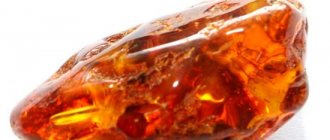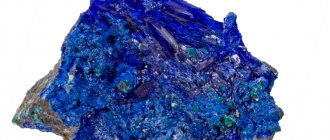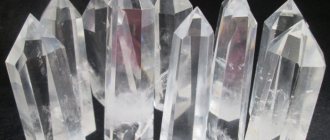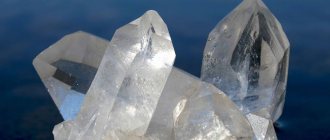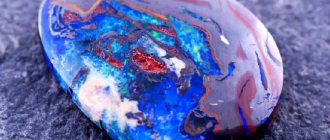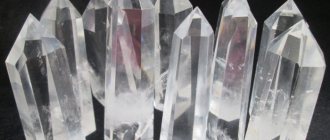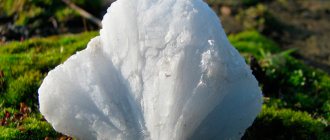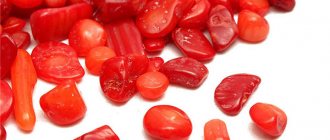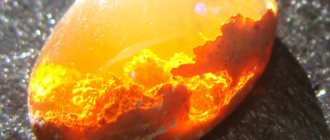This article will forever change your opinion about precious and semi-precious stones. If you consider them ordinary pieces of glass, then learn to appreciate jewelry. If these stones already impress you, you will understand why they are loved all over the world.
So. Why is one stone sold by the whole carload, while auctions are held for a gram of another? Why are even expensive minerals divided into precious and semi-precious and cost differently? In the material you will find answers to these and other questions.
What is a gemstone
First, we will define the word “stone” itself. Stone refers to rocks and minerals that were formed naturally, that is, without human intervention.
To be called precious, a stone must meet three criteria: to be rare, durable and beautiful. Let's look at each of these characteristics.
Rarity of the stone
The rarity of a stone is determined by the difficulty of its occurrence in nature. This complexity has numerical indicators, which we will illustrate using the example of diamond mining - future diamonds.
Diamond mine. Source: ALROSA
Miners dig diamond ore out of the ground, from which other specialists then extract diamond crystals. For mining to be profitable, 1 ton of ore must contain at least 0.5 diamond carats. Now imagine the following.
That's not all. Only 20% of all diamonds are suitable for jewelry. The rest goes to technical needs. It turns out that out of 1 carat mined, only 0.20 carats will end up in the jewelry. And this is only 0.040 grams.
From 1 ton of ore, 4/100 of a gram of diamond is obtained. This mass is not enough to insert even into one ring.
Imagine how much work needs to be done, how much land needs to be dug, so that every woman is happy on her engagement day!
Durability of the stone
No corporation will develop a complex deposit of stones and minerals that quickly become unusable. No person will buy products with fragile inserts. Therefore, durability is a determining factor for a stone that claims to be precious.
The durability of a gemstone is measured in hundreds and thousands of years.
The same gemstone can be hard and brittle at the same time. For example, diamond is so strong that it is used to test the hardness of other minerals. At the same time, if dropped, this crystal can crack and even break.
The beauty of stone
Beauty in precious stones is also a quantifiable concept. For example, the cost is affected by color saturation, the degree of refraction of a sun ray, the color absorption spectrum and other characteristics that professional gemologists check with special devices.
It is unlikely that a person will appreciate all these qualities at one glance. However, when you see a piece of jewelry with a precious stone on your interlocutor or in a showroom, just imagine the characteristics of the mineral, be impressed by the product and appreciate it. Think about how the stone was searched for, how it was evaluated according to all possible criteria, and how it was shaped.
Scientists have learned to synthesize rare stones, but their price is not even close to the prices of natural diamonds, rubies, sapphires and other precious stones. Only a mineral found in the depths of the earth can be considered a real gemstone.
AQUAMARINE works with precious stones that have documents confirming their authenticity. And each diamond in our products also has an evaluation certificate from a gemological laboratory.
Diamond Grading Certificate from the GIA Gemological Laboratory
A Brief History of Diamonds
It was the Hindus who first began to impart precious properties to stones. Several thousand years BC, Indian rajahs adorned themselves with diamonds found throughout the country. In those days, people did not yet know how to change the original shape of crystals.
According to popular belief, diamonds were brought to Europe by the soldiers of Alexander the Great from the campaigns. Local residents did not appreciate the beauty of uncut stones, and after several decades, kings across the continent began to decorate weapons and armor with cut diamonds. In the 15th century AD, court women and men began to wear diamonds.
Since then, thanks to deposits around the world, diamonds have become valued in every corner of the Earth.
Conspiracies
The stone not only fulfills wishes, but also hears what is asked of it. Therefore, with bodily and mental contact, it can be used for certain purposes. Conspiracies help direct energy in the right direction.
From illness
Apply to the sore spot and say three times:
“The power of the stone stops pain, take all ailments upon yourself!”
This method can be used when:
- toothache;
- migraine;
- back pain;
- bruises.
For pure thoughts
Feedback from an unrefined stone brings up difficult thoughts, fears and concerns. If thoughts become intrusive, it should be rinsed and left in clean water overnight. Looking at a stone in the water, you need to say three times:
“Clean water means pure thoughts for the stone and for me!”
It is better to dry the stone in the sun, for example on the windowsill of a south-facing window.
For good luck
You can convey a request to attract good luck into your life by squeezing the stone in your hand and saying three times:
“Failures come from us, and success comes to us!”
When casting conspiracies, you need to concentrate on your thoughts and believe in the connection with the talisman.
Wish come true
To fulfill a wish, you need to look through the hole at the Moon or the Sun and make a wish. The size of the hole does not matter at all. The hole in the stone is the eye of the spirit through which the unknown is comprehended.
What is a semi-precious stone
Manufacturers, sellers and buyers give different names to stones that are slightly cheaper than precious stones. Two equivalent terms are popular: semi-precious and jewelry stones.
Some consider the term "semi-precious stone" to be outdated. Because of the prefix, the half-value of the mineral becomes discredited. The buyer may perceive the stone as inferior and not buy a product with it. Therefore, the term “jewelry stone” came into use. Professionals will understand you if you use any of these terms.
Jewelry (or semi-precious) stones are less beautiful, rare and durable than precious stones. At the same time, they have wonderful properties to decorate your product.
Varieties and colors
Not only pebbles are used as a talisman, but also shells with a washed hole. The size, shape of the stone and the possible image on it give the amulet additional properties.
| Form | Interpretation |
| Animal | Loyalty, devotion, wisdom, longevity |
| Human head (face) | Beauty, feelings, reliable support |
| Heart | Sensuality, tenderness, love |
| Coin | Material well-being, stability |
| Round | Unity, perfection, stability |
| Oval | Protection, new life, exaltation |
| Triangular | Unity of flesh, soul, mind |
The biofield of a stone with a hole is determined by color.
Orange
The color of warmth, coziness and comfort. The stone will attract support from loved ones, consolation and reassurance. Blocks indifference, activates responsiveness, and forms a positive attitude towards change. Helps move forward and complete things started.
White
Promotes renewal of thoughts, cleansing of soul and body. Helps in new beginnings and learning. Encourages a person to be honest and frank. Blocks negative qualities: deception, betrayal, envy.
Blue
The stone stimulates the development of creativity, reveals talents and abilities. For people who are passionate about work, it helps to finish what they have started. The blue amulet provides a chance to those who are desperate and have lost hope.
Red
The color of love and sensuality. The owner of the stone will turn feelings into flaming, passionate and durable ones. Red color stimulates you to look better and be more confident.
Black
It has a powerful charge and absorbs negative energy. The stone protects against the evil eye, envy and bad thoughts. Increases business activity and organizes efficiency.
Green
Responsible for health. Ensures a speedy recovery and wards off illness. Replenishes energy, stimulates renewal and moving forward.
Colored spots
A “spotted” amulet is often found, which can combine different colors. Diversity gives the talisman versatility. The more spots of different colors, the happier the find.
Summarize
- The weight of gemstones is measured in carats.
- 1 carat is equal to 0.2 grams.
- Gemstones have three evaluation criteria: beauty, rarity and durability.
- From 1 ton of diamond ore you can get no more than 4/100 of a gram of diamond.
- Leading jewelry manufacturers only use stones with certificates of authenticity.
- Jewelry and semi-precious stones are equivalent concepts.
Now you have clear knowledge about precious and semi-precious stones, their characteristics, differences and, we hope, appreciate them.
Stay tuned for our next article. In it we will tell you how precious stones are held in jewelry.
<< Return to list of articles
What properties does it have?
A hole in a stone represents victory over difficulties and physical ailments. The hole in the middle maximizes its properties. A stone donated by nature itself protects its owner from troubles and troubles. Regardless of color and shape, it has a number of magical properties.
Protective
The talisman symbolizes the feminine principle. It protects the keeper of the home from illness, helps to cope with children and the household.
Perfect for people who have a dangerous job and put their lives at risk. Helps along the way, protects from danger.
Magical
According to legend, the stone with a hole became popular due to its magical properties. It scares away evil spirits and evil spirits. Therefore, you can wear the stone not only on your body. It is hung in the house at the entrance, near the crib of a child or adult. It improves sleep and relieves nightmares. The stone attracts good luck into life.
Healing
Actively absorbs negative energy. It is recommended to place it at the level of diseased organs. The energy field of the stone has a beneficial effect on the course of the disease. The spirit of the stone lifts you out of depression, drives away bad thoughts, and lifts your spirits.
By origin
Natural
Most minerals are of natural origin, their diversity is amazing. They are used everywhere, and the most common ones (jasper, basalt, granite, sandstone, marble) are materials for construction and landscape design.
Artificial
Synthetic minerals are created in a laboratory, so they cannot be found in nature. Some stones are created from scratch, and some are based on an existing mineral. They are widely used in construction, where a lot of the same type of material is required.
Synthetic stones are divided into the following categories:
- Cast marble;
- Polyester;
- Acrylic;
- Quartz agglomerates.
What types of classification of natural stones are accepted by mineralogists and jewelers?
There are several characteristics by which all stones are classified. The Kluge and Bauer system is most often used. The German mineral scientist Kluge compiled a list consisting of 5 groups of minerals. Three include precious samples (diamonds, topazes, opals, garnets, tourmalines), and two are reserved for simple gems. Bauer modified the system by adding non-precious crystals and formations of organogenic origin.
List of the most common rocks used by humans
Rocks, depending on their composition, method of formation, chemical characteristics and structure, are divided into classes and groups, which include individual minerals. It is difficult to describe all rocks. Some classes include from several dozen to hundreds of different elements.
The table shows a list of the most popular and widespread natural resources.
| Class | general characteristics | Group | Name |
| Silicates | Contains silicon and silicic acid salts. | Feldspars |
|
| Mica |
| ||
| Clayey |
| ||
| Soap |
| ||
| Chrysotile |
| ||
| Carbonates | These are minerals containing carbonic acid salts. | Calcite |
|
| Basic |
| ||
| Oxides | Found in all types of rocks. Contain oxides of various substances. | Quartz |
|
| Chalcedony |
| ||
| Hydroxides | Sedimentary rocks. | Limonite |
|
| Opal |
| ||
| Sulfides | Compounds of metals with sulfur and non-metals. | Pyrite |
|
| Sulfates | Salts of sulfuric acid. | Gypsum |
|
Many rocks are composed of elements belonging to different groups of fossils. The most interesting of them:
- Granite. Contains mica, quartz and feldspars. In the photo you can see different types of granite.
- Sandstone. It is formed from fragments of various rocks, which are cemented by various minerals.
- Slate. They are characterized by a layered structure formed by the compression of several rocks.
Sources
- https://rus-list.ru/734-kamni-interesnye-fakty-kotorye-zastavyat-izmenit-mnenie-kazhdogo/
- https://natrukodel.ru/svoystva/kamni
- https://MoyKamen.com/galereya/vidy-kamnej.html
- https://AwesomeWorld.ru/nezhivaya-priroda/prirodnyiy-kamen.html
- https://1nerudnyi.ru/dragotsennye-poludragotsennye-i-podelochnye-kamni/
- https://MoyKamen.com/galereya/gornye-porody-kamnej.html
Earth's Stone Gifts
Natural stones are hard pieces of rock that appear as a result of crushing. In their structure, texture and composition, they are very different from each other, and therefore there are extremely many types of them: marble, granite, limestone, as well as slates, shell rock, basalt.
Some of them were formed on land, others - under the influence of fresh or sea water. For example, some blocks were formed thanks to mollusks that, dying, sank to the bottom, covering it with shells and shells. Over time, the layer became thicker, denser and after some time collapsed, unable to withstand its own weight, as a result of which shell particles mixed and formed lumps.
Natural stones are the remains of:
- Destroyed sedimentary rocks (75%), which were formed as a result of various erosion processes, primarily weathering and destruction of rocks, mechanical or physical loss of sediment from water, and the vital activity of organisms. Some of the most well-known names for the stones include limestone (a naturally occurring white stone composed of calcium carbonate), sandstone (composed of quartz particles) and marble, a natural stone that was created by the transformation of limestone and dolomite;
- Metamorphic rocks (about 20%) are igneous and sedimentary rocks that were formed inside the planet and changed under the influence of various physical and chemical processes, primarily the pressure of aqueous and gas solutions and high temperature. The most famous natural stone of this type is quartzite, consisting of mica and quartz;
- Igneous rocks that were thrown out by volcanoes from the bowels of the Earth. The most famous type is granite - one of the hardest, most durable and dense rocks. The color of this stone is extremely varied: gray, red, brown, green.
